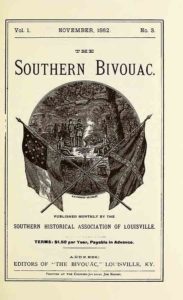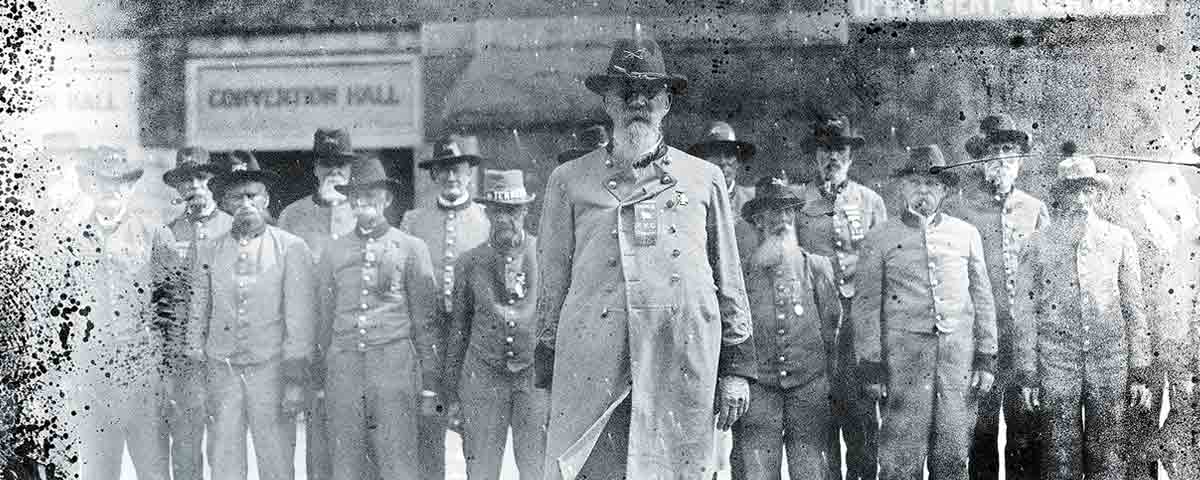Former Confederates wrote accounts of their wartime experiences for various magazines and newspapers. Most students of the Civil War are familiar with four of these publications. The most widely known of the quartet is the “Century War Series” published in The Century magazine between 1884 and 1887 and later issued in four thick volumes as Battles and Leaders of the Civil War. During the 1870s a few ex-Confederates also contributed to a Civil War series in The Philadelphia Weekly Times, and several dozen of these articles appeared in book form in 1879 as The Annals of the War. The two most important outlets for Confederate testimony were Southern Historical Society Papers (SHSP), which commenced publication in January 1876 and provided a forum for the bitter “Gettysburg Controversy” of the 1870s and 1880s, and Confederate Veteran, the inaugural issue of which appeared in January 1893. The first three of these publications featured writings by notable military officers, and SHSP, shaped by the guiding hand of Jubal A. Early, focused on events in the Eastern Theater. All four have been reprinted at least once—Battles and Leaders multiple times—and are readily available.
The Southern Bivouac, though unfamiliar to most modern readers, also offers a wealth of primary material on the Confederate war effort. Its relative obscurity stems from several factors. The publishers never issued a hardbound compilation of war-related articles from its pages comparable to The Annals of the War or the overwhelmingly successful Battles and Leaders of the Civil War. The Bivouac also enjoyed just a five-year publishing life—a very brief run compared to those of SHSP (1876-1959) and Confederate Veteran (1893-1932). It also trained its lens on events in the Western Theater rather than on the more famous battles and campaigns waged by Robert E. Lee and his army. Perhaps most important, its roster of authors included few leading military figures of the type who regularly wrote for the “Century War Series” and SHSP.

Launched in August 1882 as The Bivouac (it adopted its final name with that year’s November issue), the new magazine counted four members of Kentucky’s celebrated Orphan Brigade among its five-person editorial committee and promised to publish “all kinds of articles of interest to the ex-Confederate soldier, his family, and to all friends of the South and its history.” Early issues set patterns that would continue despite later changes of editors and ownership: articles on the Western Theater markedly outnumbered those on the East; the common soldier rather than generals frequently held the spotlight; and miscellaneous short pieces, queries, and correspondence rounded out the war-related content.
Like Early and others who shaped the SHSP, the editors of the Bivouac consciously sought to influence future generations of readers by getting the Confederacy’s version of the war down on paper. J. William Jones, editor of the SHSP, praised the Bivouac in late 1882 and welcomed its founders “as our co-laborers in the great work of vindicating the truth of Confederate history.” The Bivouac’s editor conceded that North and the South would contribute to literature on the conflict, but, he added pointedly, “the survivors of the lost cause can least afford to be silent” because the “fairest history a victor may write never does justice to the cause he conquered.”
The Bivouac departed from SHSP in important ways. Whereas the latter featured debates among prominent Confederate officers about Gettysburg and other campaigns, the Bivouac, as already noted, emphasized the importance of the common soldier (Confederate Veteran would follow its lead a decade later). “When we consider the power of ambition,” stated one editorial, “the valor of high dignitaries is easily accounted for in behalf of any cause; but the motive which impels the privates and subordinate officers to suffer and bleed so long, demands the fullest explanation.” The magazine actively solicited accounts from “the old soldiers or the members of their families.” The SHSP printed many official reports; the Bivouac announced its intention to preserve “for history the stories and incidents of the war that never appear in army reports.” In language that surely rankled Early and others associated with the SHSP, the Bivouac claimed to be “the only Confederate soldiers’ magazine published in the United States.”
[quote style=”boxed” float=”left”]The Bivouac also called for critical examination of all Confederate leaders—including Robert E. Lee[/quote]
The Bivouac also called for critical examination of all Confederate leaders—including Robert E. Lee. In a clear reference to efforts by Early and his followers to absolve Lee of blame for reverses at Gettysburg and elsewhere, the Bivouac denounced hero worship that masqueraded as history: “Really great men do not hesitate to avow their responsibilities, even of errors which prove disastrous.” The time had come to put aside personal feelings and seek historical objectivity. “That in some cases this is unpleasant to the personal friends of the heroes of history is true,” remarked the editors: “But this is of no consequence.” In a letter to Basil W. Duke, a former cavalry general who fought mostly in the Western Theater and served a stint as co-editor of the Bivouac, Jubal Early complained that the magazine published too many articles by low-ranking officers and enlisted men, printed negative comments about Lee by untrustworthy individuals, and indulged in sensationalism. Duke responded with a touch of humor, defending the Bivouac’s editorial policies and inviting Early to submit an article to the magazine.
The May 1887 issue announced that the Bivouac had been purchased by the Century Company and would cease publication (a few articles already in hand would become part of Battles and Leaders of the Civil War). In just half a decade, the editors had bequeathed to future students of the Civil War a rich store of material. Scores of articles cover major battles and campaigns and lesser known operations. Nearly every issue contains personal anecdotes relating to combat, camp life, and other facets of the soldier’s experience. The magazine also sheds a good deal of light on the Lost Cause interpretation of the Confederate war and the reconciliation movement that developed in the 1880s. A six-volume, indexed reprint (Broadfoot Publishing, 1992-93) provides a superb literary lens through which to view how the postwar South chose to remember its failed attempt to found a slaveholding republic. ✯





